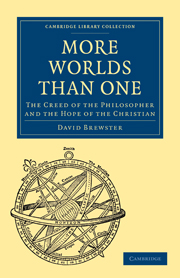Book contents
- Frontmatter
- Contents
- PREFACE
- INTRODUCTION
- CHAP. I Religious Aspect of the Question
- CHAP. II Description of the Solar System
- CHAP. III The Geological Condition of the Earth
- CHAP. IV Analogy between the Earth and the other Planets
- CHAP. V The Sun, Moon, Satellites, and Asteroids
- CHAP. VI The Motion of the Solar System round a distant Centre
- CHAP. VII Religious Difficulties
- CHAP. VIII Single Stars and Binary Systems
- CHAP. IX Clusters of Stars and Nebulæ
- CHAP. X General Summary
- CHAP. XI Reply to Objections drawn from Geology
- CHAP. XII Objections from the Nature of Nebulæ
- CHAP. XIII Objections from the Nature of the Fixed Stars and Binary Systems
- CHAP. XIV Objections from the Nature of the Planets
- CHAP. XV The Future of the Universe
CHAP. VI - The Motion of the Solar System round a distant Centre
Published online by Cambridge University Press: 29 August 2010
- Frontmatter
- Contents
- PREFACE
- INTRODUCTION
- CHAP. I Religious Aspect of the Question
- CHAP. II Description of the Solar System
- CHAP. III The Geological Condition of the Earth
- CHAP. IV Analogy between the Earth and the other Planets
- CHAP. V The Sun, Moon, Satellites, and Asteroids
- CHAP. VI The Motion of the Solar System round a distant Centre
- CHAP. VII Religious Difficulties
- CHAP. VIII Single Stars and Binary Systems
- CHAP. IX Clusters of Stars and Nebulæ
- CHAP. X General Summary
- CHAP. XI Reply to Objections drawn from Geology
- CHAP. XII Objections from the Nature of Nebulæ
- CHAP. XIII Objections from the Nature of the Fixed Stars and Binary Systems
- CHAP. XIV Objections from the Nature of the Planets
- CHAP. XV The Future of the Universe
Summary
Had our Sun, with all the planets and comets which he controls, been absolutely fixed in space, our system could have had no connexion with the other systems of the universe. The immense void which separates it from the stars, would have been regarded as the barrier which confined it. Astronomers, however, have not only placed it beyond a doubt that the Solar system is advancing in absolute space, but have determined the direction in which it moves, and within certain limits the velocity of its motion. This great cosmical truth, the grandest in astronomy, will furnish us with a new argument for a plurality of worlds.
The first astronomer who suggested the idea of such a motion, was the celebrated Dr. Halley, who was led to it by comparing the places of Sirius, Arcturus, and Aldebaran, as determined by the observations of Hipparchus and Flamsteed. The French astronomers, Cassini and Le Monnier, noticed the same fact; but it is to Tobias Mayer of Göttingen that we are indebted for a more complete examination of the subject. By comparing the places of eighty fixed stars, as determined by Roemer in 1706, with their places as observed, by Lacaille in 1750, and himself in 1756, he found that the greater number of them had a proper motion, that is, a motion that could not be explained by any cause connected with the motion of our earth in its orbit, or upon its axis.
- Type
- Chapter
- Information
- More Worlds Than OneThe Creed of the Philosopher and the Hope of the Christian, pp. 110 - 124Publisher: Cambridge University PressPrint publication year: 2009First published in: 1854



